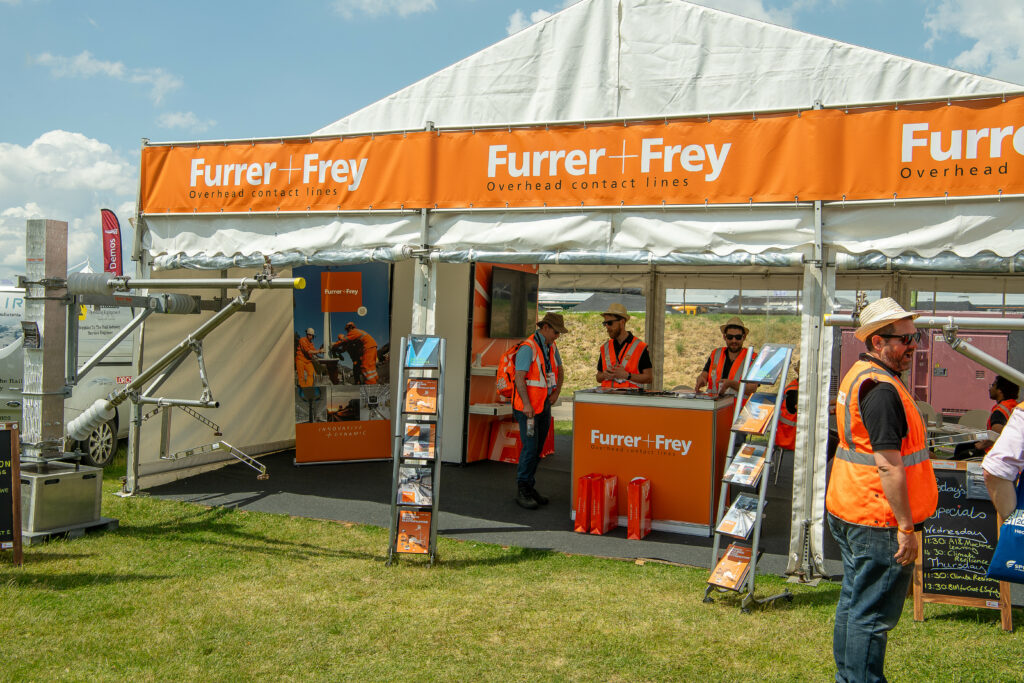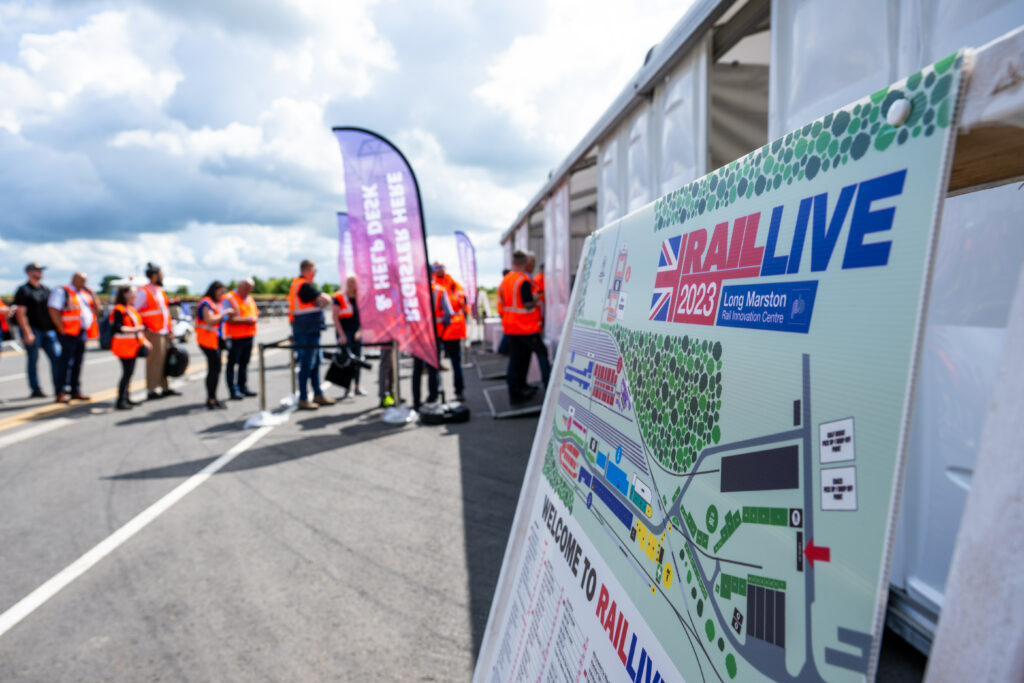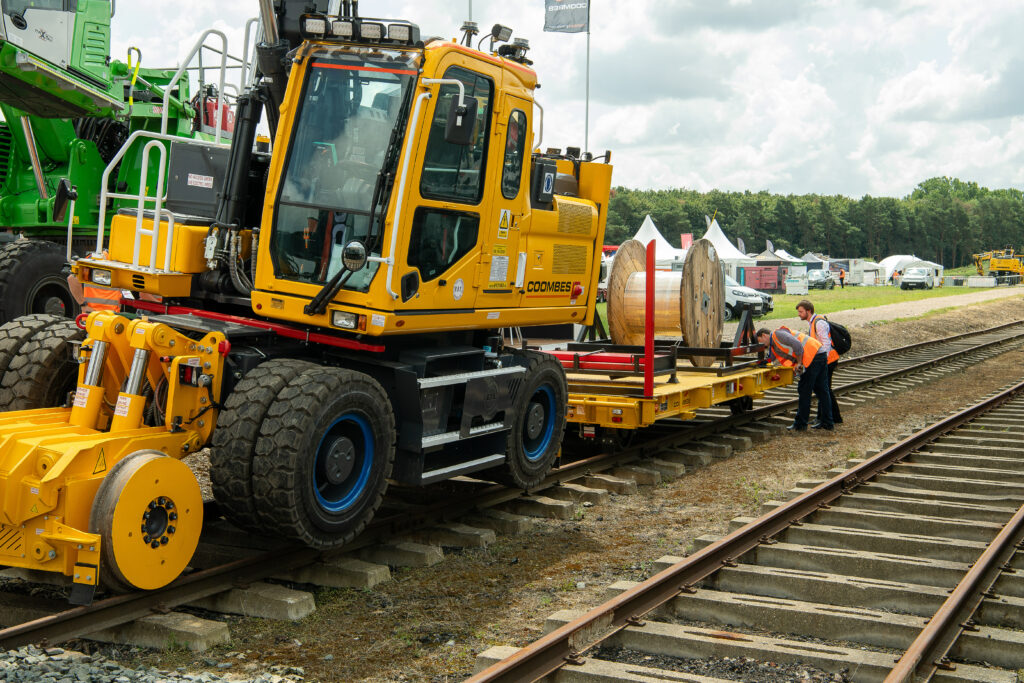Two hot and sunny days in June saw the return of the UK’s largest outdoor rail show at Porterbrook’s Long Marston Rail Innovation Centre (LMRIC) in Warwickshire, which was billed as being an even bigger and better Rail Live than ever. It is believed that there were around 6,230 visits over the two days – an impressive increase of 11% on last year.
Formerly known as the Quinton Rail Technology Centre, the 135-acre site includes a two-mile-long circular test track and almost 12 miles of sidings for secure train storage. It is linked to the national network via a two-mile branch line to Honeybourne, and rolling stock owning company Porterbrook took over the management of LMRIC in June 2021.
The site was purchased by the Ministry of Defence in 1940 as a centre for military operations. The branch line to Honeybourne is the surviving stub of a through route to Stratford-upon-Avon (itself part of the Great Western Railway’s main line between Birmingham and Cheltenham) which was closed following a derailment in 1976. It is currently the subject of a reopening campaign that has received development funding from the Government’s Restoring your Railway scheme.
Since taking over the site, Porterbrook has invested more than £10 million to upgrade LMRIC, including hard surfacing the roads, refurbishing buildings, and providing improved signage. On a part of the site closed to Rail Live visitors, more than £3 million has been invested in a three-road, fully-pitted shed that can accommodate a six-car set, with 460 metres of new rail. In the future, the intention is to also upgrade the test track to higher speed running with electrification and ETCS Level 2.
Rail Live
Visitors were greeted to Rail Live by an extensive array of yellow ‘plant’ worth tens of millions of pounds, lining the main avenue. Rail Live was originally established by Network Rail as a ‘plant show’ at its Westwood training centre. Over the years it has grown significantly to cover all aspects of rail infrastructure.

The LMRIC site is huge, with ample room for all shapes and sizes of rail plant and trains, and an impressive programme of seminars and keynote speakers took place in the Rail Live Theatre. There was also a wide range of rail equipment on display along with live demonstrations. This included a variety of exhibitions such as Network Rail’s Air Operations Team and the firearms and dog units of the British Transport Police. Over 270 exhibitors were present, representing all parts of the supply chain.
The Rail Live site is remote, with no station nearby, but a regular passenger train shuttle service consisting of Porterbrook’s Class 769 tri-mode trains ran from Honeybourne station to the site’s own private platform. The ‘769s’ are converted from a Class 319 dual-voltage electric multiple unit, with the additional capability to run on diesel power. At Honeybourne, a temporary platform was provided. The platform was constructed using Glass Reinforced Plastic (made from recycled material) and featured an advanced tri-tone surface for optimised anti-slip endurance. The lightweight, portable, and fully sustainable platform is planned to be reused at other temporary high-demand locations. A shuttle bus service was also in place from, and to, Strafford Upon Avon and Warwick Parkway stations.
There were many other highlights at Rail Live 2023, including Rail Minister Huw Merriman who attended on Thursday 22 June when he launched the second day’s seminars. He headed a high-profile attendance list that included Network Rail chair Lord Peter Hendy of Richmond Hill and HS2’s CEO Mark Thurston.
HS2 was a first time Rail Live exhibitor, showcasing a model of its Tunnel Boring Machine (TBM) named ‘Dorothy’. The full size, 125-metre-long, 2,000-tonne machine started its journey at Long Itchington Wood Tunnel’s North Portal site in Warwickshire in December 2021, and broke through the wall of the reception box at the South Portal site in July 2022. Dorothy and its huge cutter head, weighing 160 tonnes with a 10-metre diameter, was then relaunched in November last year, taking four months to complete its one-mile second bore. Work is now underway to dismantle the TBM, ready for transportation to Birmingham, where it will begin a 3.5-mile tunnel bore between Water Orton and Washwood Heath in early 2024.
The industry body Rail Forum hosted a series of mini-networking sessions to give its members across the supply chain the opportunity for networking with major buying organisations, Tier 1 contractors, and other stakeholders. The five sessions covered SME engagement, on-track plant, level crossings, seasonal delivery, and overhead line equipment.
Class 756
A Transport for Wales Class 756 Stadler FLIRT unit was among the main rolling stock attractions. Twenty-four of the tri-mode units will be introduced on South Wales Metro services, powered by discontinous electrification on lines north of Cardiff and diesel to the south, to provide cross-city connectivity. Seamless travel will be promoted through the use of overhead lines at 25kV, and through on-board battery power on non-electrified lines. To keep emissions to a minimum, diesel power will be limited to specific areas. Low flooring ensures level boarding, making it simpler for passengers to get on and off, and reduces dwell time. Air-conditioning, new passenger information systems, Wi-Fi, and areas for wheelchairs, bikes and pushchairs also feature.
Other highlights at the show were Great Western Railway’s Fast Charge Battery Train. The Class 230 unit 230001 features a Fast Charge system which unlocks the use of battery trains across the network. This train and its charging system were developed at Long Marston by the now defunct Vivarail company. The Fast Charge engineering team was on hand to discuss the technology and the future potential of the system – including the planned trial on the West Ealing-Greenford line.
Go Live with Network Rail
A Track Demo Viewing Platform and giant video screen formed one of the centrepieces in the Network Rail Village, providing visitors with a clear view of the track demonstrations by the Wales and Western Region. The demonstrations and associated displays had been developed with three Rail Systems Alliances. Rail vehicles on display included a Mobile Maintenance Train, a track tamper, Rail-Road vehicles (RRVs), and a universal material handling vehicle that is able to receive materials and distribute material via a series of conveyors.

As part of Project FRoOG (Freight Resilience of Operational Geometry), Network Rail was displaying a new vehicle that has been developed with geometry measurement equipment, to dynamically measure infrastructure. It can measure all areas of track under load and, in places where its current fleets don’t run, and measure high-risk derailment sites.
Examples of Network Rail’s Road Vehicle Fleet included a range of electric vehicles from large transit vans to much smaller vehicles. Members of Network Rail’s Commercial and Procurement, Intelligent Infrastructure, and Research and Development teams were also on hand, as were experts in Project SPEED (Swift, Pragmatic and Efficient Enhancement Delivery), which has been designed to challenge how projects are currently delivered.
Network Rail’s team of station hawks were also on display. Provided by Rentokil, these specially trained birds of prey are flown to deter gulls and other pest birds without causing them harm. Rentokil’s bird handlers use their experience and expertise to identify the most appropriate vantage points from which to fly the raptors. Also in the air, the Network Rail’s Air Ops team had its drones unit and two helicopters on display, with the opportunity to meet those who fly them.
Network Rail had a presence in Rail Live’s Signalling Zone, including a stand for the East Coast Digital Programme, and the Network Rail village was full of exciting innovation including Robodog (Spot) created by Boston Dynamics. Unlike a regular dog, Spot can detect radiation, complete thermal inspections, and gather data in his shiny yellow coat.
Within the Network Rail Village, the Sentinel team was available to meet customers and users, and to answer questions on how the core safety system allows users to check authority to work before going trackside and experience Sentinel’s recent digital makeover, the biggest enhancement to the system for a while. Intelligent Infrastructure is a digital transformation programme to improve asset management and to provide the basis for a ‘predict and prevent’ maintenance strategy.
Network Rail’s experts were on hand to explain the apps and tools which take raw data and transform it into intelligence to support effective decision making. By the end of April 2024, they will have delivered 20 new apps and tools, helping to make the right decisions at the right time to provide improved services for passengers and freight customers.
Electrification costs
Cost-effective electrification relies on more than just technology, and this was one of the themes for Siemens Mobility at Rail Live. Siemens Mobility’s electrification experts were exhibiting and explaining its technology and demonstrating its approach to delivering cost-effective electrification for a low-carbon UK rail system. This covered in-house design, UK manufacturing, delivery, and installation.
Siemens Mobility’s product portfolio was on display to show how it can optimise the use of energy across the network, including AC and DC traction power supply equipment, as well as contact line and network systems. Visitors were able to see demonstrations of the latest overhead line innovations including the SICAT SX and surge arrestors which have been developed to affordably electrify over 1,800km of Denmark’s railways. Air insulated switchgear was also on display, which is currently used in the UK, with a model of a compact version in development.
The Rail Live Theatre featured many very interesting and topical subjects and speakers. On the opening day of Wednesday June 21, John Larkinson, CEO, Office of Rail and Road covered the ‘Next steps in rail regulation: PR23 and beyond’. Andrew Haines, Network Rail chief executive and Great British Railways Lead discussed ‘Where next? The future of Britain’s railways’. Ed Akers, principal programme sponsor, East Coast Digital Programme explained ‘Digital signalling: The next generation railway.’ Mark Thurston, CEO, HS2 Ltd gave ‘An update on HS2: Overview and insights’. Emma Porter, managing director, Story Contracting discussed ‘Why diversity and inclusion matters’.


On Thursday June 22, Milda Manomaityte, innovation director, Railway Industry Association covered ‘Innovation – the supply chain perspective’. Huw Merriman, Rail Minister presented ‘Giving back control: Letting TOC MDs manage and direct.’ Lord Hendy of Richmond Hill, chair, Network Rail explained ‘Rail reform as a catalyst for the future’. After lunch, Ian Prosser CBE, HM chief inspector of Railways covered ‘Health and safety challenges in CP7’. Rikke Carmichael, head of Air Operations, Network Rail; Bradley Sparkes, national drone manager; Sean Leahy, national aerial survey specialist collectively covered ‘Aerial derived data – reaching new heights’.
The equipment on show did not only include large, yellow plant and trains. For example, Encortec was typical of many of the smaller suppliers and was demonstrating its vibration and electromagnetic energy harvesting technology. Developed from research by the University of Exeter, Encortec is removing the need to charge and replace batteries, and the need to use power cables connected to the mains for infrastructure monitoring. The concept is for a ‘fit and forget’ remote monitoring device, powered by electromagnetic energy harvesting from AC traction systems.
Vibrant
Helped by the warm weather, Rail Live was an outstanding event and this report only covers a small part of the excellent stands, discussions, and exhibitions on display. There was a vibrant buzz around the site and there was much enthusiasm evident for the future of rail.
LMRIC is a fabulous site for Rail Live, it’s just a shame it’s difficult to get to by rail. The rail link shuttle to the south was great, but how about one with the north? The success of Rail Live and the increase in numbers attending did cause some issues, notably traffic volume in and around Long Marston, long queues at registration, visitors parking on the road, delays in entering and exiting the parking, and some visitors not having badges.
It would appear that many enthusiastic visitors and exhibitors arrived at the same time and Rail Live was a victim of its own success. Many journeys to the exhibition were also delayed to due to a motorway accident, which resulted in traffic suddenly arriving at the site in the same short time. On day one, there was an incredibly long queue forming around the site. So due to health and safety concerns, with the heat and lack of shade, the decision was made to allow a number of visitors into the show without badges (approx. 350), but steps are in place to put clients and visitors in contact, in compliance with GDPR.
Like all good projects, an action plan to review the arrangements is under way and to ensure lessons are learnt and the delays do not happen again. We are sure this will be the case and we wish the organisers every success for the future of Rail Live.
Image credit: Jack Boskett

